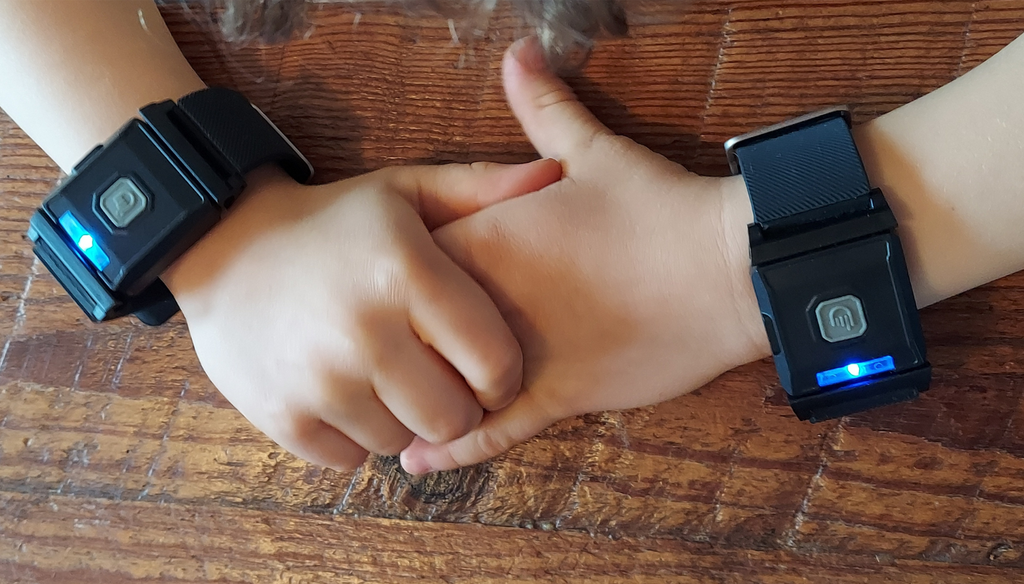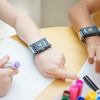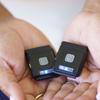TOUCHPOINTS AS A TOOL TO GROW YOUR CALM | DR. CAROLINE DANDA

TouchPoints have become a staple when helping our clients create their own toolkits that help them grow and gain their calm. We have found that the most useful set to order for kids and teens are Touchpoints for Sleep, even though they are used for much more than a good night’s sleep.
Why is it so important to understand how they work?
It’s important to know, especially for kids, that you can’t just expect them to know and understand how to use the product without introducing it, letting them experience it, and supporting their use. Without information, the vibrations may seem potentially confusing and unsettling, inadvertently creating more anxiety.
Here’s how we explain the why of TouchPoints:
When we are triggered or become overwhelmed by emotions, particularly anxiety, we are likely to get stuck in the back of the brain or on the right side of our brain that controls more emotions and aren’t able to access helpful and true thoughts. TouchPoints free this fear response and the feeling out of control or stuck. The vibrations essentially talk to both sides of our brain to even it out, and let it know it can relax or focus. When our emotions are so big that we feel like we can’t use our brain in the way we want, TouchPoints can help our nervous system calm or focus, and use our brain in a helpful way again.
Why do we love the sleep bundle and find it so much more helpful???
The helpful bilateral vibrations are amazing, but can overwhelm individuals who are sensitive to sensory issues or are experiencing heightened anxiety, which can temporarily magnify your body's reactions to sensory input.
The zippered sweatbands that come with the sleep set temper the sound enough to balance out the added sensory input that can make some feel more restless and have trouble welcoming the helpful bilateral calming vibrations. Basically, an initial resistance to a sensory input, especially one that is unfamiliar, can backfire by creating added emotional intensity. This added surge of energy can make clients more likely to feel overwhelmed and dismiss or assume the devices are unhelpful. We also suggest getting used to Touchpoints for Sleep while doing a familiar activity, rather than start off using them in bed. When we lie down in bed, our minds go quiet and may overfocus on the sensory sensations and sound of the vibration, which can be overwhelming and distract or mask the positive benefit your body is experiencing. Some children are extremely sensitive to any sensory input and can benefit from wearing a sock and putting the zipper bands over them, until their bodies have a chance to get used to them and are able to associate the buzzing with calm.
Likewise, we find that wearing the TouchPoints about 20 minutes before bed or while getting ready for bed also gets our body ready for sleep, so it’s easier to fall asleep once we crawl into our beds.
For those who like to wear TouchPoints for Sleep in bed, we love that you can turn them back on if you wake up in the middle of the night and help get back to sleep. Likewise, even if kids don’t wear them in bed, having them available by the bedside table makes them available for them to use if they wake up in the middle of the night, and might keep them from crawling out of their beds and into yours. It gives them a plan and support for falling back asleep.
Having the 30-minute automatic shut off available in the TouchPoints for Sleep model means kids (or adults even) don’t accidentally leave them on, and so the Touchpoints remain charged for when they are needed.
The soft sweatbands are also easy to wear on ankles so they don’t get lost, and they don’t get in the way when using our hands to do something.

Why (and How) to Create a Routine?
TouchPoints are not something that kids, in particular, will automatically grab when they need calm or focus. Just like any other tool, they have to learn their benefit by experience. One of the best ways to do that is to incorporate TouchPoints as part of a daily routine. For example,
- In the morning after waking up to help them focus. (YELLOW)
- In the car on the way to school (YELLOW for focus, BLUE for calming if it’s a been a stress and a rush to get out the door)
- On the way home from school or other activities to support the transition from one activity to another. (BLUE)
- Pair Touchpoints with listening to music for added benefit.
- Before sitting down to do homework or sitting down for a meal, especially at a restaurant (YELLOW)
- For younger kids with excessive energy or kids with ADHD (YELLOW)
Why Should Parents, Caregivers, and other Adults Use Touchpoints?
As we mentioned earlier, the fact is that kids will imitate and want to follow what they see the adults in their lives doing rather than what they say or try to logically convince their children of good reasons for doing something. When parents use Touchpoints themselves, often quietly without attracting attention to them, kids can often become interested and ask questions. Then you can provide explanations and offer to let them try to see if they are interested. Provide matter of fact information about them, about how they help your brain slow down, your body feel calmer, and it’s easier to get things done – whatever they do for you. Only offer to let them try them after they show an interest. It may take several inquiries until they are truly interested, or only one. Regardless, kids love it when you can frame trying them out as an experiment.
The other reason that parents and other caregivers should use Touchpoints is that adults also often get over-stimulated, overwhelmed by emotion, or struggle with motivation. When the caregivers in a child’s life are better able to regulate their emotions and attention, they are more available and less reactive when parenting. In this way, kids can also catch the calm of their trusted adults, and adults can provide a safe haven or anchor in a child’s emotional storm.
Why TouchPoints in Therapy?
In our therapy sessions, TouchPoints add amazing clinical benefits and support other interventions.
For example, some clients may initially have difficulty tolerating EMDR (Eye Movement Desensitization and Reprocessing). Wearing TouchPoints on the calm speed setting (BLUE) improves regulation and tolerating EMDR while working through difficult topics.We also often invite kids, and even adults, to use Kwik Stix to express emotions and color back and forth, as well as play soothing music with binaural or bilateral beats in the background, to further enhance nervous system regulation. All of these activities allow clients to feel more emotionally safe to dive in and less scared of “what” might come up or that they are somehow doing it “wrong.”
Another example is having the child wear the TouchPoints on the calm speed setting (BLUE) while using the simple dimple, or other fidget involving bilateral movements, letting their brain feel safe enough to chew up the parts and let go of their old story that are no longer useful or helpful. Their body can also get rid of built-up energy that they have been holding onto that may be making them feel scared or yucky, like something bad might happen.
When addressing topics that can be emotionally overwhelming, difficult to talk about or express, TouchPoints helps calm the nervous system. Clients feel more emotionally and physically safe, similar to having a calm and trusted adult in session with you who serves as a co-regulator. TouchPoints save time in the therapeutic process by helping children and adults stay regulated enough to wade into difficult topics more quickly. This is particularly helpful when having a primary caregiver or trusted adult in the room is not an option.
Sometimes adults have a difficult time hearing and handling the things that come up in session, making it difficult to stay regulated themselves, and be helpful. The TouchPoints can be used by the important adults in the child’s life to help them learn to tolerate distressing thoughts or behaviors that their children may share. Often an adult's response to hearing something that their child is struggling with dictates their level of distress and if they will choose to continue open communication or pull back, not wanting the added distress that their parent or parents are feeling.
We often have kids with ADHD or have excessive energy wear them in session to settle their bodies and help them focus during play, bibliotherapy, or other therapeutic activities.
Even some of our colleagues who are pediatricians and nurse practitioners use these in their office for kids and teens who come in presenting with anxiety and depression. The TouchPoints can make the patients feel more at ease to discuss their concerns and thus make assessment easier for providers.
Wearing TouchPoints 15-30 min on the way to therapy is another way to help prepare children by allowing them to be in a calm state, which enhances their readiness and ability to learn these skills.
In sum, we have seen great benefits using TouchPoints both in our offices and outside of our offices. We wanted to share how kids, families, and professionals can get the most out of these tools to grow their calm. Let us know if you’ve used TouchPoints and what works for you to grow your calm.
Visit Touchpoints for more information and to check them out for yourself.
Use code RIPTIDE for a discount!**
**We earn a small affiliate compensation. We only affiliate and recommend products that we use ourselves and find beneficial personally or professionally and have been recommending already!




